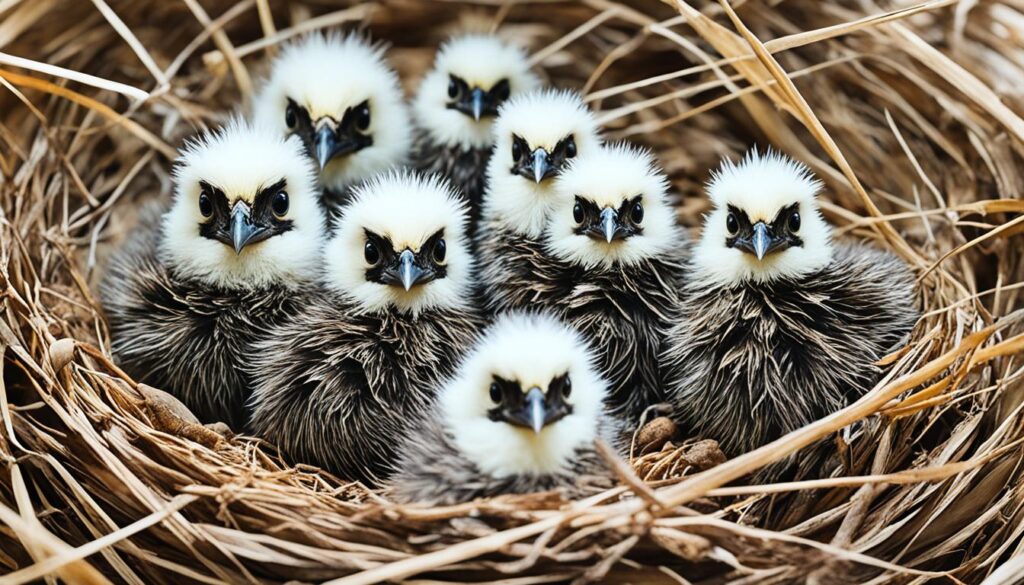Did you know that more than 90% of bird species begin as nestlings? The baby bird world is full of unique names. Each one shows a different stage of growth. You start with tiny hatchlings, then move on to nestlings, and end with fledglings that are close to maturity. Knowing these names helps bird lovers talk about and recognize young birds.
Key Takeaways
- Baby birds have specific names that refer to their stage of growth. These include hatchlings, nestlings, and fledglings.
- Young birds called fledglings spend a lot of time learning from their parents. This process lasts until they can live on their own.
- Nestlings, baby birds that are not ready to fly, are in danger if they fall to the ground. They might need quick help from animal rescue centers.
- Fledglings, birds that have left the nest but can’t fly, are sometimes wrongly taken from nature. This can cut their chances of making it if they lose their parents.
- Knowing the names for baby birds lets bird watchers talk about and spot the young of many bird types.
Introduction
Baby birds are truly amazing, showing us incredible change from the moment they’re born. They differ from each other a lot, from how they look and act to how much they need their parents.
Unraveling the Mysteries of Baby Bird Development
We use special words to talk about baby bird growth stages. Each stage, from hatching to adulthood, has its own terms and unique features. This includes hatchlings, nestlings, and fledglings.
Ostrich hatchlings can be as large as 2 lbs, the biggest in the world. On the other hand, a bee hummingbird’s chick is as small as a coffee bean. This shows how different baby birds can be in size.
How fast baby birds grow and learn varies a lot too. Some songbird like white-eyes might fledge after only 10 days. But with baby bald eagles, it can take over 3 months. The differences are quite fascinating.
Some baby birds, like ducks and gulls, jump from heights as their first move. This can be hundreds of feet. It shows their strong nature and quick learning ability.
Pigeons and flamingos can produce a special liquid, crop milk, for their young. This trait shows a link despite how different these birds might seem.
Learning about baby birds helps us see the surprising variety and depth of bird life. From the smallest to the biggest, each one is full of wonder.
Generic Names for Baby Birds
Each bird type has special names for its babies. But, there are common words we can use for any baby bird. These names help us understand a bird’s beginning to when it’s grown.
Hatchling, Nestling, and Fledgling
For baby birds, we often use the terms hatchling, nestling, and fledgling. A hatchling is newly hatched and has no feathers, needing its parents completely. When it grows feathers, we call it a nestling. At this stage, it stays in the nest and depends on its parents for care.
The next step is the fledgling. It has special feathers for flying and starts to leave the nest. It starts to learn to be on its own, though parents still watch over it. They might not fly well at first, but they’re getting more independent.
| Baby Bird Stage | Description |
|---|---|
| Hatchling | Newly hatched, featherless, and helpless |
| Nestling | Covered in down feathers, still confined to the nest and dependent on parents |
| Fledgling | Has developed flight feathers, exploring outside the nest but still relying on parents |
Knowing these words for baby bird stages is a great start to discover baby birds. Learning about hatchlings, nestlings, and fledglings is very interesting.

Unique Names for Baby Birds by Family
More than just “hatchling” or “fledgling,” bird families have special names for their young. Knowing these names can make it easier to talk about what you see when birdwatching.
For chickens, a young male is a cockerel and a young female is a pullet or poult. Cranes call their babies colts. Doves have cute names for their babies, like squabs and squeakers.
There are many more unique names for baby birds:
- Eaglets are young eagles
- Eyases are baby falcons
- Goslings are young geese
- Ducklings are baby ducks
- Keets or guinea-keets are young guineafowl
- Owlets are baby owls
- Peachicks are young peafowl
- Pufflings are baby puffins
- Cygnets or flappers are young swans
- Jakes and jennies are young turkeys
These special names help birdwatchers talk clearly about what they see. Knowing the names shows how much we care and understand baby birds.
Chicken Babies: Poults, Cockerels, and Pullets
Chickens have special names for their young ones. A baby chicken is a poult. A young male is a cockerel, and a young female is a pullet. These words come from Old English and French. They mean “male bird” and “hen.”
The term “pullets” means young female chickens. And “cockerels” means young males. We can also call baby chicks “juveniles”. Female chickens are known as “hens” and males as “roosters.” When chicks start getting feathers, they are called pullets or cockerels.
Male chickens become roosters when they are ready to mate. Female chickens become hens when they lay eggs. Hatcheries use “started pullet” and “started cockerel” for birds at a certain stage. Broody means a mother hen is hatching eggs or looking after chicks.
“Biddy” is a name for female chickens, young or old. In the UK and Australia, people might call them “chooks.” This is a slang word for all chickens in those places.
| Chicken Terminology | Definition |
|---|---|
| Poult | A baby chicken |
| Cockerel | A young male chicken |
| Pullet | A young female chicken |
| Hen | An adult female chicken |
| Rooster | An adult male chicken |
| Juvenile | A young chicken of either sex |
| Broody | A mother hen setting on eggs or raising chicks |
| Biddy | A term for both juvenile and mature female chickens |
| Chook | A slang term for chickens used in the UK and Australia |
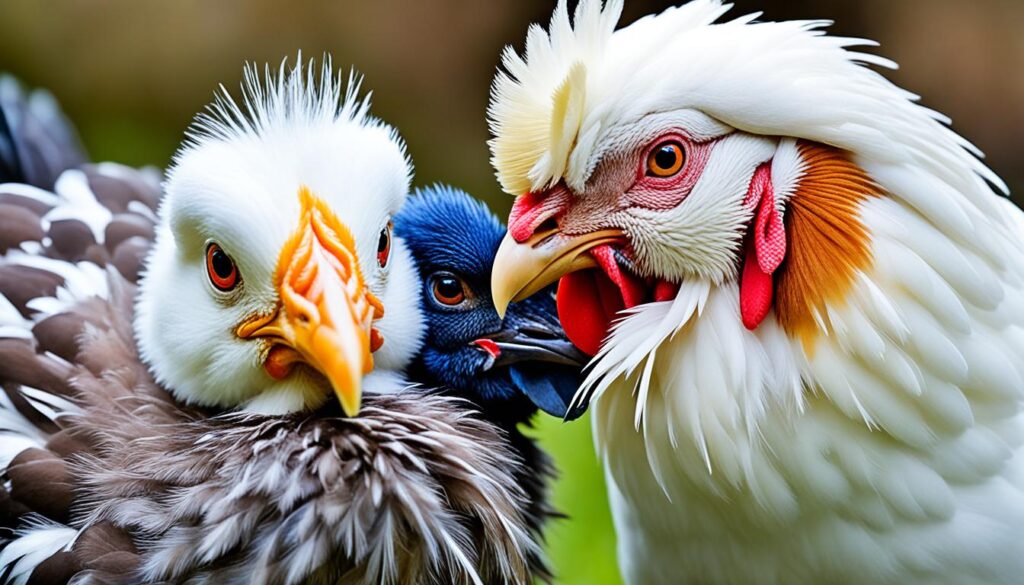
The names and stages of baby chickens are interesting. They help us learn more about these cute poults, cockerels, and pullets.
Crane Babies: Colts
Baby cranes, known as colts, are very special. They are part of the Gruidae family of cranes. The name “colt” shows how their long legs make them look a bit like young horses. They can start moving around quickly after being born.
At places like REGI, people care for Sandhill Crane colts. They work with multiple chicks at once. These tiny birds are only six inches when they hatch. But, they can grow very fast, doubling in size in just a week. Caregivers walk these colts up to two miles every day to help their muscles grow strong.
Wild crane parents keep a close eye on their colts and the people caring for them. They stay within five feet, showing a strong connection with their young. If the weather is bad and the colt can’t be released to the wild, caregivers limit their interaction. This helps keep the colts’ natural behavior intact.
Among all crane species, Sandhill cranes are the most common. They mate for life between ages two and seven. These large birds can live over 20 years. But, they face dangers from both nature and humans. In Washington state, there were only 32 nesting pairs found in 2016.
As baby cranes grow up, they face some tough challenges. They must learn how to fly. This takes about two months. In that time, they’re in danger from many predators such as coyotes, ravens, and even eagles.
But, crane parents do everything they can to protect their young. Both the mother and father watch over the eggs and the nest. The dedication of these birds to keep their species going is truly remarkable. Despite everything, cranes have been around for millions of years. They are a symbol of strength in the bird world.
Dove Babies: Squabs and Squeakers
In the Columbidae family, including doves and pigeons, there’s special lingo for their young. Dove chicks are called squabs or squeakers. These names come from the loud cheeps and squeaks they make all the time. These sounds help the parents find and look after their babies.
Baby doves usually come out of their eggs a day apart. They start out needing everything from their parents, including food and water. After about 11 or 12 days, they can fly. Sometimes, they end up on the ground for a bit, learning to fly up to trees for safety.
The Adorable Sounds of Baby Doves
The cute sounds of baby doves, or squeakers, fill the air early on. These peeps and coos are the way they communicate with their parents. They show where the babies are and what they need. As they grow, their sounds turn into the adult dove’s gentle coos.
“Pigeon squabs feed on ‘crop milk’ produced by both parents for the first 5 days, gradually incorporating small seeds and invertebrates into their diet until they are independent.”
Going from squabs who need everything to fledglings who are almost ready to be on their own is quite the journey. This process, along with the lovely sounds they make, is fascinating. It’s an amazing part of the bird world.
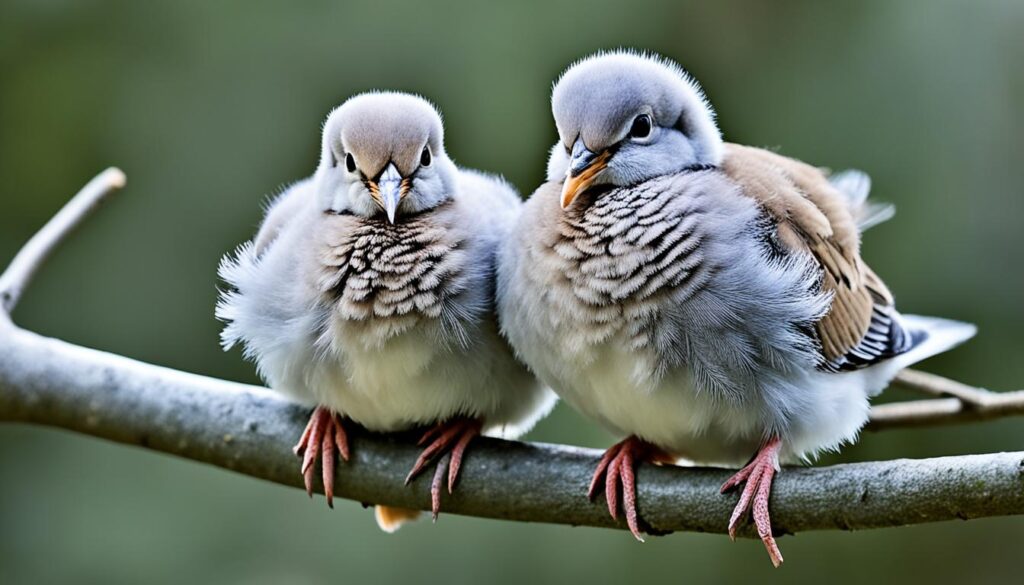
| Baby Dove Terminology | Description |
|---|---|
| Squab | A baby pigeon or dove less than 4 weeks old and not yet ready to fly |
| Squeaker | The high-pitched peeps and coos of a baby dove |
| Fledgling | A young dove that has grown its flight feathers and can flutter from the nest, typically around 11-12 days old |
Duck Babies: Ducklings
The young of waterfowl species, including ducks, geese, and swans, are called ducklings. This name comes from the Old English suffix “-ling,” which means small or young. It’s used in other words like “gosling” and “fledgling.” Ducks can be found everywhere on earth except for Antarctica. Some are even known to travel long distances, especially those in the Northern Hemisphere.
Ducklings usually stick with just one partner. This partnership can last for up to a year. However, bigger duck types and those that stay in one place may be together for multiple years. Most ducks have babies once a year when conditions are good, like in spring or summer. Mother ducks protect and care for their young. But in some cases, they might leave them behind if they’re not doing well or get stuck.
Ducks eat in different ways. For example, some just pick food off the water’s surface or land while others dive deep underwater for theirs. Ducks can look very different from each other. Some have beautiful feathers that they lose during the summer, revealing a simpler, different look.
| Duck Species | Duckling Weight | Duckling Incubation Period | Duckling First Flight |
|---|---|---|---|
| Mallard | 30-40 grams | 28-30 days | 40-60 days |
| Muscovy | 30-40 grams | 36 days | 40-60 days |
| Call | 30-40 grams | 28-30 days | 40-60 days |
| Pintail | 30-40 grams | 28-30 days | 40-60 days |
Ducks are part of a group that also includes geese, swans, and more. Most fall under the Anatidae family. Unfortunately, ducklings have a tough time surviving, with up to 70% dying in harsh winters or from predators. But they’re quick learners, able to find food soon after birth. They leave the nest after about two months, ready to fly, under their parents’ watch.
“A group of ducklings is known as a ‘raft,’ which is a delightful and appropriate term for the adorable way they float together on the water’s surface.”
Eagle Babies: Eaglets
The young of big birds like eagles, hawks, and falcons are called eaglets. This name makes them sound small and special, showing their mighty nature early on. Eaglets change a lot as they get older, just like all other raptor chicks.
The Majestic Young of Raptors
Eaglets are in their nests for about 10 to 12 weeks. They reach full size by 9 weeks old. The mother eagle is usually at the nest almost all the time, but the father is there about half the time once the babies come. They get fed 1-8 times each day, and the parents tear the food for them.
As eaglets get older, they might fight with their brothers and sisters. The strongest one sometimes tries to boss the others or even hurt them. By 5 to 6 weeks, young eagles start looking over the edge of their nest, and they get very hungry by 8 weeks old.
Eagles might have more than one nest in their area. This helps keep their main homes clean. Young eagles cannot do much when they first hatch. They need the adults to take care of them until they can fly away.
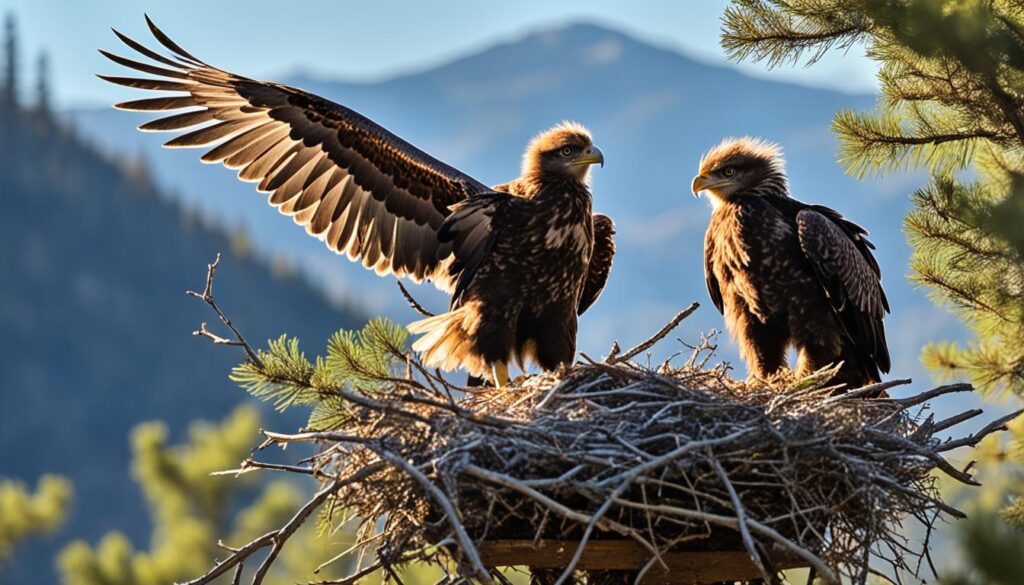
When a bird’s feather is hurt, it can be fixed by a process called imping. Raptors, like eagles, can turn their heads much farther than we can. They have twice as many neck bones as we do, which lets them turn their heads a full 180 degrees.
By six or seven weeks, eaglets can stand up and do short “jump flights.” They also like to play. They eat more as they get bigger. At this time, they learn to protect themselves by looking big, hissing, and pretending to be dead.
Most eaglets leave the nest when they’re around 12 weeks old. Sometimes, they jump early because they get scared by people. After they learn to fly, they keep practicing their skills for a few more weeks. During this time, their parents still give them food.
Falcon Babies: Eyases
In the world of baby birds, the youth of falcons and certain other birds have a unique name – eyases. From the French word “niais,” it originally meant “caught from the nest.” This word evolved over time to “eyas” in English. It is a term specific to falconry, talking about baby falcons.
Baby falcons, or eyases, are truly special. They hatch after about 33 days of being kept warm by their falcon parents. These young birds start an amazing journey. Peregrine falcons, for example, usually fly to warmer lands in winter but return to where they were born by early March.
As eyases grow, they learn how to hunt exceptionally well. Peregrine falcons can swoop down on prey in the air at speeds reaching 250 miles per hour. They use their sharp claws to catch the other bird, then carry it away. Their meals often include pigeons, starlings, and other birds or ducks.
The change from an eyas to a full-grown falcon is quite the show. The young birds lose their fluffy feathers and get the beautiful feathers adults have. This change shows us how amazingly these birds can adapt and thrive.
“Eyases are a specialized term used in the sport of falconry to refer to falcon chicks.”
Fans of falcons and bird experts are always learning more about these amazing creatures. The story of eyases and their growth is endlessly interesting. From their hunting skills to their movements between lands, baby falcons share a peek into the exciting world of these bird predators.
what do you call baby birds of Other Species?
There are specific names for the babies of various bird species. For example, baby geese are known as goslings, and grouse chicks are cheepers or squealers. Using these special names adds beauty to our language and helps us see bird diversity.
Goslings, Cheepers, Keets, and More
Did you know goslings are baby geese? Grouse chicks get the cute names of cheepers or squealers due to their sounds. And for guineafowl, you’d call their young keets.
There’re more like baby quails called chicks or quaillets, young owls as owlets, and baby parrots as parrots or chicks. Even baby hawks and falcons are unique; they are called eyas.
Learning about these names not only adds to what we know. It also helps us respect and enjoy the beauty of nature.
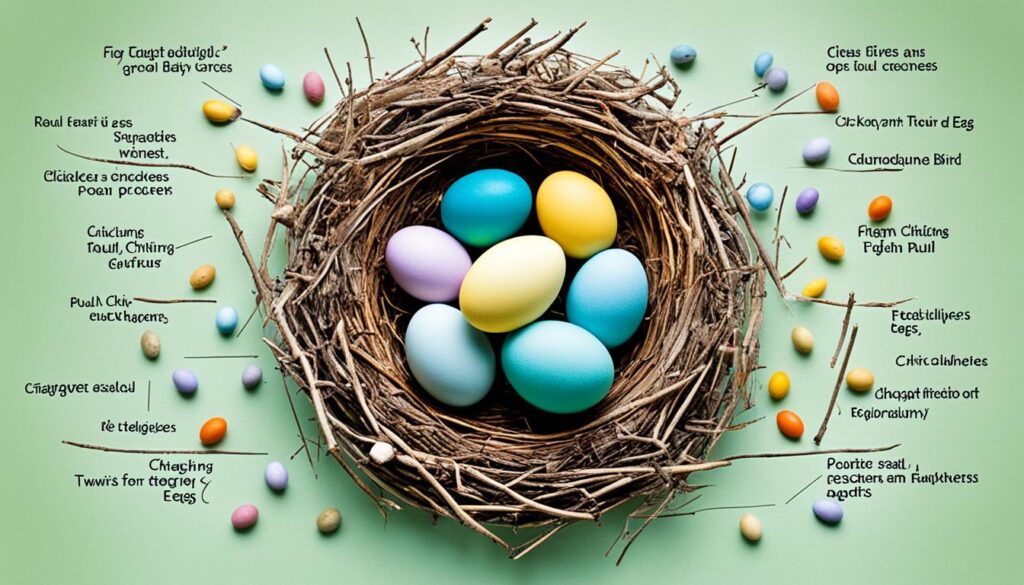
“The more you know about the details of nature, the more you’ll appreciate its beauty.”
The Transition from Baby to Adult
Young birds grow up through several life stages before becoming full adults. In these stages, they lose some awkwardness but still look young. They learn to take care of themselves but are not grown up yet. Birders can tell how old birds are by their appearance. This helps them identify birds at different life stages.
Juvenile, Immature, and Subadult Birds
Songbirds and hummingbirds are born needing a lot of care. But ducks and chickens can walk and eat right away. Bald eagles and some gulls take several years to look like adults.
Young songbirds live in a nest until they can fly. When they fly for the first time, it’s not very far. Their parents leave them alone to find food for about an hour. After flying, juvenile birds still get food and care from their parents for a few more weeks.
| Stage | Description |
|---|---|
| Juvenile Birds | Have grown past the most awkward stages but still retain some youthful features and camouflage. |
| Immature Birds | Have left the nest and care for themselves, but are not yet sexually mature. |
| Subadult Birds | Are more developed than immature birds, but still lack the distinct field marks and plumage of fully adult individuals. |
“Understanding the different stages of bird development can help us appreciate the amazing transformation these feathered creatures undergo on their journey to adulthood.”
Spotting Baby Birds in the Wild
Seeing a baby bird in the wild is thrilling for nature lovers. From a small hatchling to a curious fledgling, young birds always catch our eye with their movements. Knowing how to spot and identify these baby birds makes their presence even more enjoyable.
Spotting baby birds starts with knowing what they look like. Hatchlings are mostly featherless with closed eyes. They have a big head compared to their body. Nestlings have soft, fluffy feathers but their wings and tail are not fully grown. Fledglings are almost ready to fly but they still hop or flutter a lot.
Watching baby bird behavior is also helpful. Hatchlings and nestlings are often in their nests, making peeping sounds. They chirp to get food from their parents. Fledglings might be on the ground, trying to fly by moving their wings awkwardly.
“The thrill of spotting a baby bird in the wild is unparalleled. It’s a reminder of the incredible diversity and resilience of the natural world.”
Identifying baby birds can be fun, but remember they’re fragile. Be careful around them and don’t touch them. Watching from afar and respecting their space ensures we don’t disturb these special moments of their lives.
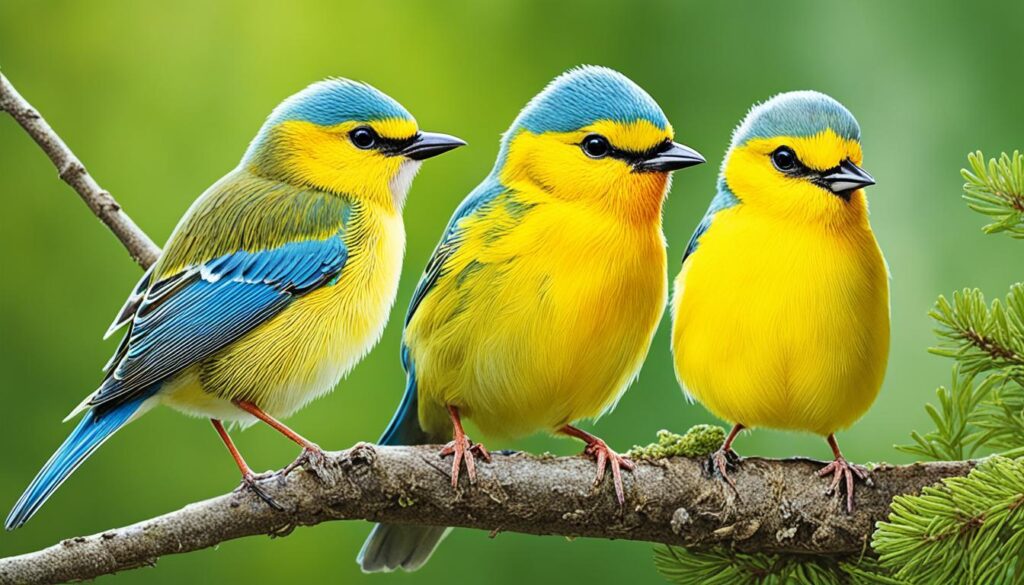
Caring for Found Baby Birds
When to Intervene and When to Leave Them Be
Finding a baby bird can make us want to help. But it’s key to know when they need our help. In many cases, baby birds are cared for by their parents, even if they seem left alone. It’s risky to get too close or try to feed them.
If a baby bird looks hurt or sick, we should get help from a local wildlife center. This place has experts who know how to help. They will give the bird the right care so it can go back to the wild someday.
- Hatchlings and nestlings found on the ground are vulnerable and likely to die without assistance.
- Look for signs of sickness or injury, such as dirty, matted, or missing feathers, visible wounds, or drooping wings.
- The Migratory Bird Treaty Act of 1918 prohibits the keeping of wild birds, so it’s illegal to do so.
If you choose to help, it’s important to be very gentle. Take the baby bird to a safe, warm place before bringing it to the experts. Remember, the wildlife professionals are often the best hope for the baby bird’s care.
“Removing a native bird from its environment is illegal. If you find a naked nestling bird with sparse feathers or none at all, it is likely a nestling that has fallen or been pushed from a nearby nest. If you can’t find the nest, put the baby bird where its parents can find it and where it will be safe from cats.”
Knowing when to help or let them be is vital for baby birds. It helps us care for them properly while keeping the balance of nature. With the right information and caring attitude, we can help the baby birds that need us.
Conclusion
The world of baby birds is diverse and fascinating. It offers a rich vocabulary to describe their unique features and growth stages. Understanding these terms can make us appreciate avian biology more. Observing and respecting baby birds allows us to connect with nature deeply. It also helps ensure their wellbeing.
Learning about baby birds’ lives is an eye-opening experience. From their start as hatchlings to their journey to becoming adults, it’s amazing. We see the incredible care and efforts by bird parents. Witnessing fledglings’ first flights teaches us about their resilience and the bird world’s complexity.
Understanding the mysteries of young birds’ development enriches our view of them. Embracing their specific terms and growth stages makes us better bird lovers. It turns us into advocates for wildlife and its protection. We become stewards of the environments that support these amazing creatures.
FAQ
What are the different names for baby birds?
Different stages of a bird’s growth have unique names. They start as hatchlings, then become nestlings, and finally fledglings. Each bird family gives unique names to their young too. For instance, baby chickens are called poults, cockerels, and pullets. Baby cranes are called colts.
What are the stages of a baby bird’s development?
Baby birds grow through distinct stages, from juvenile to subadult. These stages are marked by changes in their looks, actions, and how much they rely on parents.
How can I identify a baby bird I see in the wild?
Looking at a baby bird’s feathers, size, and how it acts tells you a lot. Learn the special names for baby birds in various species. This makes it easier to know what type of bird it is.
What should I do if I find a baby bird that appears to be in distress?
If you find a baby bird that seems hurt, don’t try to help it on your own. Leave it to the experts. Contact a local wildlife rehabilitation center for advice. They can provide the best care for the bird.
